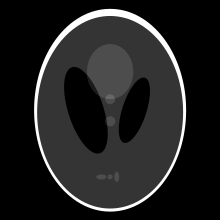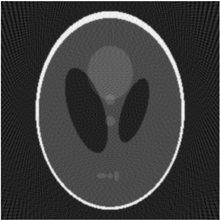Radon transformation
The Radon transform is an integral transform of a function into two variables. The line integral of the function along all straight lines of the - plane is determined. For each of these straight lines, the Radon transform can be imagined as a projection of the function onto a straight line perpendicular to it. The Radon transformation is related to the Fourier transformation and represents a generalization of the Abel transformation and a special case of the Hough transformation in two dimensions . The variant extended to complex numbers is called the Penrose transformation .
The Radon transformation is named after the Austrian mathematician Johann Radon . He introduced it in 1917 in the publication On the determination of functions by their integral values along certain manifolds . An important practical application of this transformation, more precisely the inverse transformation, is in computed tomography for image acquisition.
definition
Let be continuous and zero identically outside a circle of finite radius and be a straight line that is defined by the angle to the x-axis and its distance to the origin. Then the Radon transform is given by the line integral of along .
The straight line can be parameterized as . This means that the line integral can also be written as
Inverse transformation
The back transformation can take place with the help of the filtered back projection or via the detour of the Fourier transformation .
The reverse transformation problem is a poorly posed problem because the solution is not a continuous function of the input data. In order to solve the problem with sufficient accuracy, regularization techniques or iterative methods can be used.
Application of the Radon Transformation
In tomography, the integrals of a function are determined using straight lines and images are calculated from them using inverse Radon projection. For example, in computed tomography with X-rays, the absorption of the radiation is determined along a straight line from the X-ray source to a detector, that is to say the integral over the absorption. Instead of X-rays, other rays such as gamma radiation, as in positron emission tomography, can also be used. In all of these variants, the measurement takes place for a large number of such straight lines in a plane in which many detectors and many positions of the radiation source are moved around the object to be transilluminated. The radon transformation of the radiation absorption is determined, albeit only for a finite number of values of the two parameters. The two-dimensional image can be obtained from these values with the help of the inverse transformation. Stringing together several such two-dimensional “sectional images” results in a three-dimensional image.
Test images are used to evaluate the imaging algorithms, as shown below on the Shepp-Logan test image. The Shepp-Logan test image is a graphic as it occurs in a similar form in medical diagnostics, a simplified sectional view through the human head:
- Shepp-Logan picture sequence
The reverse transformed image with artifacts caused by the finite resolution
Individual evidence
- ^ Johann Radon: Reports on the negotiations of the Royal Saxon Society of Sciences in Leipzig. Mathematisch-Physische Klasse, Volume 69, 1917, pages 262-277
- ^ AK Louis: Inverse and Badly Asked Problems. Teubner, 1989 (Chapters 6.1 and 6.2)
Web links
- Application of the Radon transformation for CT images (PDF file; 4.07 MB)
- MathWorld page
- Further explanations













